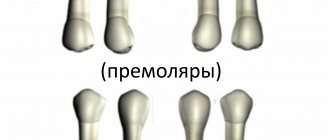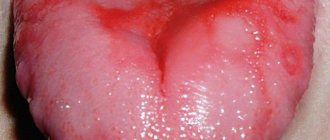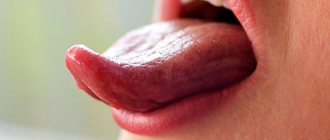What is glossitis?
What do we know about the tongue as an organ? We know that it is located in the mouth, which helps us articulate and pronounce words correctly, helps us mix food, feel all the diversity of existing tastes, that they can be shown indignation, and in some African countries, a demonstration of it can be used to declare war.
Such a significant number of different physiological and social functions may one day be compromised. And the name of this threat is glossitis.
Despite the absolutely clear location of this organ, there are big questions about which doctor deals with its problems: a dentist, gastroenterologist, maxillofacial surgeon or otolaryngologist. This is not an easy question, and sometimes you can endlessly go from one specialist to another. But let's finally understand this intriguing matter.
Diagnostics
Diagnosis of desquamative glossitis of the tongue is not easy, because sometimes it is necessary to exclude many diseases. For this purpose, different methods are used in laboratory studies:
- microbiological;
- biochemical;
- morphological;
- immunological;
- serological.
Patients undergo blood, stool, and saliva tests, and, if necessary, receive consultations from additional specialists. This is a dermatologist, allergist, endocrinologist, gastroenterologist, and often also a psychotherapist.
Forms and types of disease
Inflammation of our organ of taste occurs frequently and does not always manifest itself with symptoms, proceeding completely hidden from us.
There are several forms and types of the disease:
- According to the duration, the disease is divided into acute (develops quickly and lasts no more than a month) or chronic glossitis (lasts more than a month);
- According to the form of the lesion, the catarrhal form (proceeding with redness and swelling) and the desquamative form (proceeding with a change in appearance) are distinguished;
- purulent forms - phlegmon and abscess (a purulent focus in the thickness of the organ tissue itself);
- a separate group includes neurological diseases of the nerves innervating this organ.
Cellulitis and abscess occur acutely, they are associated with infection and require urgent surgical intervention. They manifest themselves as severe pain, chills and swelling of the lymph nodes of the neck - this form can be confused with acute inflammation of the salivary glands, so diagnosis using ultrasound and x-rays is needed. It is better not to delay these symptoms and seek medical help as an emergency.
The catarrhal form of glossitis manifests itself with a sharp blood supply - the tongue swells, becomes bright red - this can manifest itself, for example, with scarlet fever, or an allergic reaction, which, in addition to the organ of taste itself, spreads to the soft palate with the tongue. Treatment in this case is aimed at eliminating the allergic reaction and inflammation.
The largest and most heterogeneous group is desquamative glossitis. It is difficult to list the number of factors (external, internal) that can provoke this form of the disease. We will not make a mistake if we say that “the tongue is the mirror of the digestive tract.” Since it contains many nerve receptors and papillae of different shapes and purposes (filamentous, cone-shaped, mushroom-shaped, leaf-shaped, groove-shaped), a change in each link of its anatomy outwardly reveals a hidden disease. Let's take a little look at the most common diagnostic signs of these conditions.
Symptoms
The main signs of the disease are:
- the appearance of uneven plaque with pronounced white spots;
- ulcers form along the entire surface, gradually spreading to the rest of the oral cavity;
- tongue mobility is limited, sharp pain appears when talking or eating;
- color changes, local spots of different shades are visible;
- swelling, there are tooth marks on the side areas;
- impaired salivation;
- there is an unpleasant odor from the mouth.
In some cases, the sense of taste changes or disappears, and a burning or itching sensation is felt at the slightest movement. As it progresses, body temperature rises, cervical and submandibular lymph nodes enlarge.
Changes in appearance depending on the disease
One of the common types is “geographical tongue,” in which its upper surface resembles a map with the borders of countries and continents. This is the most common form of glossitis, which does not manifest itself in any way and does not require medical intervention unless complications arise (numbness, burning). This form occurs in waves, provoked by rough or spicy food, and hormonal cyclic changes. But the loss of the pattern of the papillae may indicate the presence of hypo- or hyperacid gastritis (that is, with increased or decreased acidity of gastric secretions) - such symptoms are typical for patients with gastroesophageal reflux, when hydrochloric acid and bile are thrown from the stomach into the oral cavity.
"Geographical language"
The second most common type of glossitis is a folded tongue. This is an independent type of glossitis. In this case, the back of the tongue seems to be riddled with deep cracks and it feels like there are folds in it. This form of glossitis sometimes accompanies neurological diseases (for example, Melkerson-Rosenthal syndrome) and is present in people with acromegaly (hormone-active pituitary tumor).
"Folded tongue"
Also characteristic are manifestations of various anemias, which are reflected in the appearance of the organ: iron deficiency anemia can manifest itself as a burning sensation on the tip of the tongue, the appearance of cracks on it and an erased pattern of taste buds. Pernicious anemia (B12 deficiency), in which the tongue has a “varnished” appearance with a smooth, swollen surface, sometimes quite painful, with burning symptoms, is the main cause of Gunther-Miller glossitis.
"Lacquered Tongue"
A large group of pathological conditions of this organ are ENT-associated symptoms associated with chronic tonsillitis - here the symptoms are non-specific, ranging from a dirty coating on the tongue to manifestations of diphtheria with white masses that are difficult to remove.
They also distinguish the formation of ulcers on the tongue - aphthous glossitis, which, as a rule, has a viral cause and goes away on its own. This is a recurrent disease, with more frequent episodes it is necessary to exclude pathology of the immune system.
When visiting a doctor, you will often notice pronounced teeth marks on the side of the tongue - a sign of long-term swelling. This occurs in patients with enterocolitis, kidney disease and cardiovascular diseases. The reason for this condition is water retention in the body.
Imprints from teeth on the lateral surface of the tongue
In the presence of abundant white plaque, accompanied by pronounced redness of the oral mucosa, one should suspect a fungal infection, often of a candidal nature. In this case, HIV must be excluded. Also with HIV, “hairy leukoplakia” occurs, when the tongue appears to have white hairs on the side surface, similar to flames - this condition is specific to HIV.
"White Hairy Tongue"
It is worth noting the existence of a “black hairy tongue”, which is a symptom of gastrointestinal disorders, less commonly a fungus.
"Black Hairy Tongue"
As you can see, our organ of taste reflects deep processes in the body, and it is difficult to single out one specialist responsible for its treatment. It is worth involving doctors of different spectrum in therapy, conducting studies based on data from smears and blood tests. But what general recommendations can we, as doctors, give to patients?
Answers to popular questions about glossitis
Do I need to clean my tongue?
Yes, definitely.
A lot of microorganisms accumulate on the tongue, which leads to bad breath. In case of acute glossitis, the primary task is to relieve inflammation; you can use oral baths or rinses with antiseptic solutions (chlorhexidine, miramistin), a decoction of chamomile has a positive effect (has a calming effect on inflamed tissues of the mucous membrane of the tongue and the oral cavity as a whole). Also, do not forget about careful cleaning of the surface of the tongue.
There are special scrapers (semi-oval) for cleaning the tongue. They are designed to gently cleanse the tongue. Do not clean your tongue with brushes or spoons, as this can cause injury.
Which doctor should I contact to treat glossitis?
If tongue pathology is detected, you can consult a dentist. And, if necessary, the dentist will refer you for consultation to other specialists if this is due to the presence of a general disease.
What diagnostics are carried out before treating glossitis?
The specialist to whom the patient contacted conducts an examination of the oral cavity, collects a medical history, data on the general condition of the body (the presence of chronic organ diseases, etc.), prescribes tests, as well as laboratory diagnostics: a smear or culture of the oral cavity and tongue to determine pathogenic microflora.
Are glossitis inherited?
Yes, some forms can be inherited, for example, a folded tongue.
Is it possible to completely cure glossitis?
Some forms can be successfully treated, but often glossitis is a chronic and congenital disease. But with proper therapy, you can achieve minimal manifestations of the disease.
Care instructions
- Hygiene. We brush our teeth, but forget about our tongue. Thanks to advertising in the media, people are more likely to buy toothbrushes with a special brush for cleaning the tongue - and this is important. After all, bacteria live in the gap between the taste buds and food particles remain that must be removed from there.
- Caring for your oral health. Do not forget about the cleanliness of the palatine tonsils and the presence of reflux of gastric contents into the oral cavity.
- And the most important thing is to monitor your general health, undergo a timely examination by a doctor to identify the cause of inflammation - primarily to the dentist, but if you even consult a therapist or an infectious disease specialist, or an ENT doctor - you will not be mistaken, since there are almost no diseases, which would not affect such an important organ one way or another.
Anatomy of the tongue
The tongue is divided into: body, apex and root. The tongue consists of muscles and is covered with epithelium. Also on the back of the tongue there are many special papillae with which we feel taste. The largest grooved papillae are located closer to the root of the tongue. In the center of the tongue there are filiform papillae, on the sides there are leaf-shaped papillae. And in front of the tongue there are mushroom-shaped papillae.
Hairy black tongue (villous glossitis)
This form of glossitis is characterized by the growth and keratinization of filiform papillae (they become hair-like). The mechanism of development of this disease is not fully understood. According to one version, the development of villous glossitis is facilitated by the influence of local irritating factors, as well as candidiasis that develops while taking antibiotics.
Treatment of this form of glossitis includes mechanical (tweezers) removal of filiform papillae and subsequent treatment of the surface of the tongue with a solution of copper sulfate. For candidiasis, antifungal agents are prescribed.
Reasons for the development of pathology
Glossitis is an external manifestation of diseases of internal organs caused by a deficiency of certain vitamins. Key development factors:
- Pernicious anemia is caused by a reduced level of vitamin B12 and folic acid. A decrease in the absorption of substances occurs as a result of long-term drug therapy, gastrointestinal disorders, oncological diseases of the digestive organs, autoimmune diseases, and congenital metabolic pathologies. Vegetarians, nutritional deficiencies, or alcoholism may have mild deficiencies.
- Pellagra is a disease that develops due to deficiency of nicotinic acid (B3, PP). Patients with nutritional deficiencies are susceptible. Provoke the development of stomach diseases, UV irradiation, antibiotic therapy.
- Sprue – manifested by gastrointestinal dysfunction. Identified in patients who visited endemically unfavorable areas.









